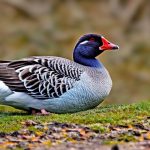Geese control is a common issue faced by many property owners, especially those who live near bodies of water or open fields. Geese can cause a variety of problems, including property damage and health risks. Finding a solution that effectively deters geese without causing harm to them is crucial. One method that has gained popularity in recent years is the use of high frequency sound waves. These devices emit sound waves at a frequency that is uncomfortable for geese, causing them to seek out quieter areas. In this article, we will explore the science behind high frequency sound waves and how they can be used as a humane and effective solution for geese control.
Key Takeaways
- Geese can be a nuisance due to their droppings, noise, and aggressive behavior.
- High frequency sound waves can be an effective way to deter geese without harming them.
- When choosing a high frequency device, consider the range, power source, and durability.
- Positioning the device near water or feeding areas can increase its effectiveness.
- Common mistakes to avoid include using the wrong frequency and not regularly maintaining the device.
Understanding the Problem: Why Geese are a Nuisance
Geese can be a nuisance for several reasons. Firstly, they can cause significant property damage. Their droppings are not only unsightly, but they can also corrode building materials and create slippery surfaces. Additionally, geese may damage lawns and gardens by trampling on vegetation and digging up soil in search of food.
Furthermore, geese can pose health risks to humans and other animals. Their droppings can contain harmful bacteria such as E. coli and Salmonella, which can contaminate water sources and cause illness if ingested. Geese may also become aggressive during nesting season, posing a threat to people and pets who come too close to their nests.
It is important to find a solution that addresses these issues without causing harm to the geese themselves. High frequency sound waves offer a humane alternative to traditional methods of geese control.
The Science Behind High Frequency Sound Waves
High frequency sound waves work by emitting a noise that is uncomfortable for geese, causing them to seek out quieter areas. Geese have highly sensitive hearing and are able to detect sounds at frequencies that are beyond the range of human hearing. By emitting sound waves at these high frequencies, geese can be effectively deterred from an area.
The concept behind high frequency sound waves is based on the principle of aversive conditioning. When geese are exposed to a sound that they find unpleasant, they associate that sound with the location and learn to avoid it. Over time, the geese will learn to avoid the area altogether, resulting in a reduction in their presence.
How to Choose the Right High Frequency Device for Your Needs
There are several types of high frequency devices available on the market, each with its own unique features and capabilities. When choosing a high frequency device for geese control, it is important to consider factors such as the size of the area you need to cover, the level of geese activity, and any specific requirements or restrictions you may have.
One type of high frequency device is a portable unit that can be easily moved around to different areas. These devices are ideal for smaller properties or areas with sporadic geese activity. They are typically battery-powered and emit sound waves at a frequency that is uncomfortable for geese.
Another type of high frequency device is a stationary unit that is designed to cover a larger area. These devices are often powered by electricity and can emit sound waves at a higher volume and frequency than portable units. They are ideal for larger properties or areas with high levels of geese activity.
When choosing a high frequency device, it is important to read reviews and compare different models to find one that suits your specific needs. Additionally, consider consulting with a professional who specializes in geese control for expert advice.
Placement Matters: Where to Position Your High Frequency Device
Proper placement of your high frequency device is crucial for optimal results. The goal is to create an environment that is uncomfortable for geese and encourages them to seek out quieter areas. Here are some guidelines on where to position your device:
1. Identify areas where geese are most active: Take note of areas where geese congregate or where they cause the most damage. These are the areas where you should focus your efforts.
2. Position the device at eye level: Geese have excellent eyesight and are more likely to be deterred by a device that is at eye level. Mount the device on a pole or fence at a height that is easily visible to geese.
3. Cover a wide area: If you have a large property or multiple areas that need to be protected, consider using multiple devices to cover a wider area. This will increase the effectiveness of the deterrent and ensure that geese are deterred from all areas.
4. Consider the direction of the sound waves: High frequency devices emit sound waves in a specific direction. Position the device so that the sound waves are directed towards the areas where geese are most active.
By following these guidelines, you can maximize the effectiveness of your high frequency device and effectively deter geese from your property.
Common Mistakes to Avoid When Using High Frequency Sound Waves

While high frequency sound waves can be an effective solution for geese control, there are some common mistakes that people make when using these devices. Here are some tips on how to avoid these mistakes:
1. Not using enough devices: Geese can be persistent and may become accustomed to the sound waves if they are not strong enough or if there are not enough devices to cover the entire area. Make sure to use enough devices to effectively deter geese from all areas of your property.
2. Placing the device too close to human activity: While high frequency sound waves are safe for humans, they can be annoying if placed too close to areas where people spend a lot of time. Make sure to position the device away from patios, seating areas, and other areas where people gather.
3. Not monitoring and maintaining the device: High frequency devices require regular monitoring and maintenance to ensure optimal performance. Check the batteries or power source regularly and replace them as needed. Clean the device to remove any dirt or debris that may affect its performance.
By avoiding these common mistakes, you can ensure that your high frequency device is effective in deterring geese from your property.
Other Methods for Keeping Geese Away: Pros and Cons
While high frequency sound waves are an effective and humane solution for geese control, there are other methods that can also be used. Here are some pros and cons of these methods:
1. Physical barriers: Installing physical barriers such as fences or netting can prevent geese from accessing certain areas. This method is effective but can be expensive and may not be aesthetically pleasing.
2. Repellents: There are various repellents available on the market that can deter geese from an area. These repellents typically contain chemicals or natural ingredients that geese find unpleasant. While this method can be effective, it may require frequent reapplication and may not be suitable for all environments.
3. Habitat modification: Modifying the habitat to make it less attractive to geese can also be an effective method of control. This can include removing food sources, such as grass or plants that geese feed on, or altering the landscape to make it less suitable for nesting.
Each method has its own pros and cons, and the effectiveness may vary depending on the specific situation. It is important to consider factors such as cost, aesthetics, and long-term sustainability when choosing a method for geese control.
Balancing Environmental Concerns with Geese Control
While geese control is important for property owners, it is also crucial to balance environmental concerns. Geese are a natural part of the ecosystem and play a role in maintaining biodiversity. It is important to find a solution that effectively deters geese without causing harm to them or disrupting their natural behavior.
When using high frequency sound waves or any other method for geese control, it is important to consider the impact on other wildlife and the environment. Avoid using methods that may harm other animals or disrupt the natural balance of the ecosystem. Additionally, consider implementing measures to attract and support other wildlife species that can help control geese populations naturally, such as installing birdhouses or planting native vegetation.
By balancing environmental concerns with the need for geese control, you can ensure that your efforts are effective and sustainable in the long term.
Legal Considerations: Are High Frequency Devices Allowed in Your Area?
Before using a high frequency device for geese control, it is important to check the legal regulations in your area. Some jurisdictions may have restrictions on the use of certain types of devices or may require permits for their use. It is important to comply with these regulations to avoid any legal issues.
To ensure that you are using a high frequency device legally, contact your local wildlife or environmental agency for information on the regulations in your area. They can provide guidance on what types of devices are allowed and any specific requirements or restrictions that may apply.
Monitoring and Maintaining Your High Frequency Device for Optimal Results
To ensure optimal results, it is important to monitor and maintain your high frequency device regularly. Here are some tips on how to do this effectively:
1. Check the batteries or power source regularly: High frequency devices are typically battery-powered or require an electrical power source. Check the batteries or power source regularly to ensure that they are functioning properly. Replace batteries as needed and ensure that the device is receiving adequate power.
2. Clean the device: Dirt, debris, and other contaminants can affect the performance of your high frequency device. Clean the device regularly to remove any dirt or debris that may have accumulated. Use a soft cloth or brush to gently clean the device, taking care not to damage any components.
3. Test the device periodically: Periodically test the device to ensure that it is emitting sound waves at the desired frequency and volume. This can be done by standing near the device and listening for the sound waves or using a sound meter to measure the frequency and volume.
By monitoring and maintaining your high frequency device regularly, you can ensure that it is functioning properly and effectively deterring geese from your property.
Success Stories: Real-Life Examples of High Frequency Geese Control
High frequency devices have been successfully used by many property owners to control geese populations. Here are some real-life examples of people who have used high frequency devices for geese control:
1. John, a homeowner in a suburban neighborhood, was facing issues with geese congregating on his lawn and causing damage. He installed a high frequency device near his property, and within a few weeks, noticed a significant reduction in geese activity. The device effectively deterred the geese without causing harm to them.
2. Sarah, a golf course manager, was struggling with geese nesting on the course and leaving droppings on the greens. She installed multiple high frequency devices around the course, strategically positioning them to cover all areas. The devices successfully deterred the geese, allowing the golfers to enjoy the course without any disruptions.
These success stories highlight the effectiveness and humane nature of high frequency devices for geese control. By using this method, property owners can effectively deter geese without causing harm to them or disrupting their natural behavior.
Geese control is a common issue faced by many property owners, and finding a solution that effectively deters geese without causing harm to them is crucial. High frequency sound waves offer a humane and effective solution for geese control. By emitting sound waves at a frequency that is uncomfortable for geese, these devices can effectively deter them from an area.
When using high frequency devices for geese control, it is important to consider factors such as the size of the area, the level of geese activity, and any specific requirements or restrictions. Proper placement of the device is crucial for optimal results, and regular monitoring and maintenance are necessary to ensure its effectiveness.
While high frequency sound waves are an effective solution for geese control, it is important to balance environmental concerns and consider the impact on other wildlife and the ecosystem. By following these guidelines and considering high frequency devices as a humane and effective solution, property owners can successfully control geese populations and maintain a harmonious environment.
If you’re looking for effective ways to keep geese away from your property, you may also be interested in learning about the benefits of using high-frequency sound devices. These devices emit sounds that are unpleasant to geese, deterring them from settling in your area. To find out more about this innovative method, check out this article on Poultry Wizard. It provides valuable insights into how high-frequency sound can be used as a humane and efficient solution for keeping geese at bay.
FAQs
What is high frequency sound?
High frequency sound refers to sound waves that have a higher frequency than what is audible to the human ear. These sound waves typically have a frequency of 20,000 Hz or higher.
How does high frequency sound keep geese away?
Geese are sensitive to high frequency sound and find it uncomfortable. When high frequency sound is emitted in an area where geese are present, they will typically leave the area to avoid the discomfort.
Is high frequency sound harmful to geese?
No, high frequency sound is not harmful to geese. It simply makes them uncomfortable and encourages them to leave the area.
Can high frequency sound be used to keep other animals away?
Yes, high frequency sound can be used to keep a variety of animals away, including rodents, insects, and birds.
Are there any downsides to using high frequency sound to keep geese away?
One potential downside is that high frequency sound may also affect other animals in the area, including pets and wildlife. Additionally, high frequency sound may not be effective in all situations and may require multiple devices to cover a larger area.
Meet Walter, the feathered-friend fanatic of Florida! Nestled in the sunshine state, Walter struts through life with his feathered companions, clucking his way to happiness. With a coop that’s fancier than a five-star hotel, he’s the Don Juan of the chicken world. When he’s not teaching his hens to do the cha-cha, you’ll find him in a heated debate with his prized rooster, Sir Clucks-a-Lot. Walter’s poultry passion is no yolk; he’s the sunny-side-up guy you never knew you needed in your flock of friends!







